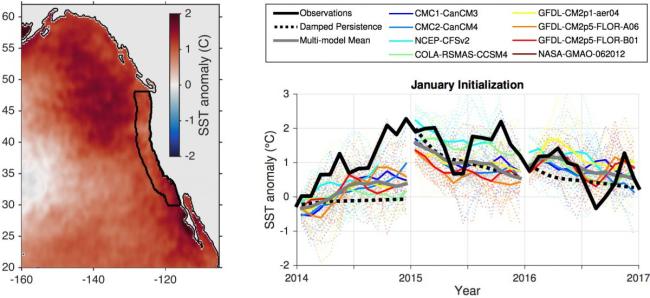Diverse processes driving a heatwave’s evolution result in conditional forecast skill for the US West Coast
From 2014 to 2016 the US West Coast was hit by an unprecedented marine heatwave. The anomalously high surface ocean temperatures resulted in a large harmful algal bloom, unusual mortality events for marine mammals and seabirds, shifts in the availability of commercial fish species, unforeseen interactions between fishers and protected species, and significant economic losses for fishing communities all along the coast. Given the significant ecological and economic consequences of these warm temperature anomalies off the US West Coast, Jacox, Tommasi, and co-authors asked the question: could they have been predicted?

(left) Mean 2014-2016 sea surface temperature anomaly (SSTa) in the Northeast Pacific. The US West Coast region highlighted in the study, which extends 300 km offshore, is outlined in black. (right) Observed (black) and forecast SSTa off the US West Coast. Model forecasts, initialized in January of each year, are shown in color. For each model, an ensemble of ~10 forecasts is generated (dotted colored lines) and the ensemble mean for each model is shown as a solid colored line. The multi-model mean (the average of all forecasts from all models – 85 total) is shown in gray. The “damped persistence” forecast (dotted black line) simply assumes that observed anomalies gradually fade to zero. It represents a baseline against which model forecast skill can be tested. Click image to enlarge.
To answer this question, the authors explored sea surface temperature anomaly (SSTa) forecasts from an ensemble of eight global climate prediction systems contributing to the North America Multi-Model Ensemble (NMME). They found that predictability was conditional on which process was driving the temperature anomalies in different phases of the heatwave. Forecast skill was high during the initial phase of the heatwave in early 2014, with the models correctly predicting an onshore evolution of a pre-existing offshore warm patch (known as “the Blob”). The early 2016 increase in SSTa was also forecasted accurately by models, as the 2015-16 El Niño generated predictable forcing from the south. However, the ensemble mean forecast failed to predict late 2014 and mid 2015 changes in SSTa, which were associated with anomalous wind patterns not adequately captured by the global climate prediction systems. Nevertheless, the model ensemble showed elevated probabilities of high SSTa throughout the heatwave, hinting at the potential of probabilistic marine heatwave forecasts for this region.
In addition to highlighting prospects for a marine heatwave early warning system off the US West Coast, this study provides insight into global climate forecast systems and the potential to improve them. In particular, the spread of forecast ensemble members was quite large, and the ensemble mean forecast tended to be correlated more strongly with observations than with individual ensemble members. In other words, the ensemble mean forecast was more skillful than would be expected based on the statistics of the model itself. This phenomenon, known as the “signal to noise paradox”, suggests that some teleconnections – the pathways by which predictability can be imparted to different regions of the ocean – may be too weak in the climate models. Model developments that improve the fidelity of these teleconnections can likely improve forecasts for marine heatwaves and other climatic events.
Predicting the Evolution of the 2014–2016 California Current System Marine Heatwave From an Ensemble of Coupled Global Climate Forecasts (Frontiers in Marine Science)
Topics
- Ocean Heat
- Modeling
- Ecosystem Impacts
- Extreme Events
